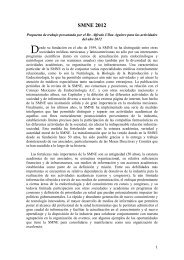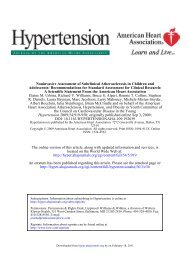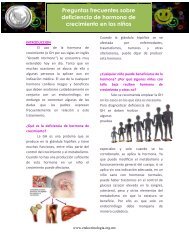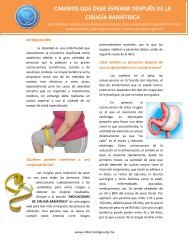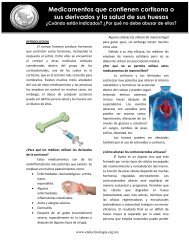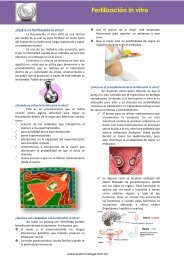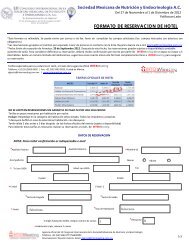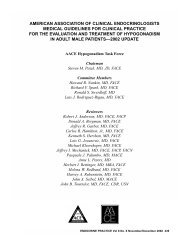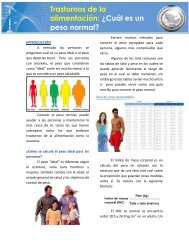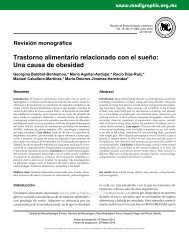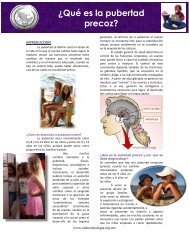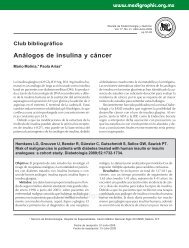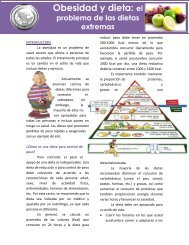Evaluation & Management of Adult Hypoglycemic Disorders
Evaluation & Management of Adult Hypoglycemic Disorders
Evaluation & Management of Adult Hypoglycemic Disorders
Create successful ePaper yourself
Turn your PDF publications into a flip-book with our unique Google optimized e-Paper software.
AN ENDOCRINE SOCIETY CLINICAL PRACTICE GUIDELINE<br />
Drugs that can cause hypoglycemia<br />
Many drugs in addition to insulin, insulin<br />
secretagogues, and alcohol have been reported to<br />
cause hypoglycemia (12–15, 18–21, 24). Many <strong>of</strong><br />
these are listed in Table 2 (24).<br />
Drugs, <strong>of</strong>ten in the setting <strong>of</strong> critical illnesses<br />
including renal failure, are the most common cause <strong>of</strong><br />
hypoglycemia in hospitals (18). Again, insulin or<br />
insulin secretagogues are common <strong>of</strong>fending drugs<br />
(18, 25), particularly when administered when<br />
enteral or parenteral nutrition is interrupted or when<br />
sensitivity to insulin is increased (e.g. after<br />
withdrawal <strong>of</strong> glucocorticoid therapy). Hypoglycemia<br />
is a sentinel event for many <strong>of</strong> the systems errors that<br />
compromise the safety <strong>of</strong> hospitalized patients (26).<br />
These include failure to reconcile admission orders<br />
with preadmission medications and diet, frequent<br />
transfers between hospital units, frequent travel <strong>of</strong><br />
patients for radiological and surgical procedures and<br />
other diagnostic and therapeutic interventions, and<br />
inappropriate use <strong>of</strong> an insulin sliding scale.<br />
Clinical evaluation<br />
Persons with a hypoglycemic disorder present<br />
clinically with a history either <strong>of</strong> discrete spells<br />
compatible with hypoglycemia or <strong>of</strong> a serendipitously<br />
measured low plasma glucose concentration. Careful<br />
elicitation <strong>of</strong> the history <strong>of</strong> the spells, noting the<br />
specific symptoms, their timing and duration, and any<br />
aggravating and relieving factors, is essential for the<br />
formulation <strong>of</strong> a diagnostic course <strong>of</strong> action. Persons<br />
with only neurogenic symptoms (with no<br />
documented low glucose levels) are unlikely to have a<br />
hypoglycemic disorder. However, even one episode <strong>of</strong><br />
neuroglycopenia warrants a diagnostic evaluation.<br />
Initially, the history (including exposure to any<br />
medications), the physical examination, and a careful<br />
review <strong>of</strong> available laboratory data guide the<br />
evaluation. These will usually either provide clues to<br />
a cause <strong>of</strong> hypoglycemia or exclude hypoglycemia<br />
caused by acknowledged medications, critical<br />
illnesses, hormone deficiencies, or a nonislet cell<br />
tumor (Table 1). A test <strong>of</strong> adrenocortical function is<br />
reasonable, although adrenocortical failure is not<br />
commonly found as a cause <strong>of</strong> hypoglycemia in adults<br />
in the absence <strong>of</strong> other clinical clues. A seemingly<br />
low plasma cortisol concentration measured during<br />
spontaneous hypoglycemia is not sufficient evidence<br />
<strong>of</strong> adrenocortical insufficiency because <strong>of</strong> the effect<br />
<strong>of</strong> recurrent hypoglycemia to shift glycemic<br />
thresholds for cortisol secretion to lower plasma<br />
glucose concentrations (10). Although hypoglycemia<br />
in patients with nonislet cell tumors is <strong>of</strong>ten the<br />
result <strong>of</strong> tumor overproduction <strong>of</strong> incompletely<br />
processed IGF-II (27), hypoglycemia attributed to<br />
overproduction <strong>of</strong> IGF-I has also been reported (28).<br />
Nonislet cell tumor hypoglycemia is usually, but not<br />
invariably, associated with large, clinically apparent<br />
mesenchymal tumors. The tumors typically secrete<br />
excessive amounts <strong>of</strong> pro-IGF-II. This form <strong>of</strong> IGF-II<br />
binds poorly to its binding proteins and therefore<br />
more freely penetrates tissue spaces. The total level <strong>of</strong><br />
IGF-II may be normal, but the ratio <strong>of</strong> pro-IGF-II to<br />
IGF-II may be elevated; this can be demonstrated by<br />
chromatographic techniques, most easily and rapidly<br />
using thin layer chromatography (29). Because <strong>of</strong><br />
suppressed GH secretion and the resulting low IGF-I<br />
levels, IGF-II to IGF-I ratios are elevated (27). Free<br />
IGF-II (or IGF-I) levels are increased (30), but these<br />
measurements are not yet generally available.<br />
Endogenous insulin secretion is suppressed<br />
appropriately in nonislet cell tumor hypoglycemia.<br />
In a seemingly well individual, the differential<br />
diagnosis narrows to two general categories:<br />
accidental, surreptitious, or even malicious<br />
hypoglycemia and endogenous hyperinsulinism<br />
(12–15). Careful consideration <strong>of</strong> the former<br />
possibility (22) should precede a systematic assessment<br />
<strong>of</strong> the latter possibility. Pharmacy errors (e.g.<br />
substitution <strong>of</strong> a sulfonylurea for another medication)<br />
and medical treatment errors occur (31). Surreptitious<br />
hypoglycemia (22, 32–35) is more common in people<br />
with knowledge <strong>of</strong>, and access to, glucose-lowering<br />
medications. Malicious hypoglycemia (22, 36, 37) can<br />
be accomplished by administration <strong>of</strong> insulin or an<br />
insulin secretagogue.<br />
Clinically, insulinoma is characterized by spells <strong>of</strong><br />
neuroglycopenia due to endogenous hyperinsulinemic<br />
hypoglycemia occurring primarily in the fasting state<br />
but occasionally only in the postprandial period<br />
(23, 38, 39). The incidence is approximately 1 in<br />
10



